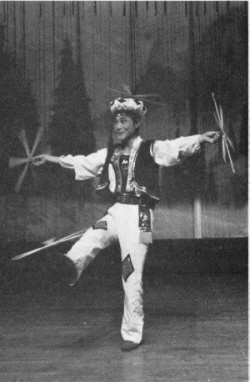
Dai Shucheng
supports a full load of Chinese flying boards. |
Page 14 Fall 1986
|
Flying
boards travel East with Dai Shucheng
In
his entire 40-year worldwide performance career. Dai Shucheng said
he had never seen anything like the
The
IJA's guest artist at the San Jose convention tossed up to five of the
crosstied sticks in graceful arcs around his body. He caught each
one surely between his palms as it circled back to him, then waved
happily to the last one as it approached as if saying. "Come
home, you're safe now!"
Dressed
in a shining gold silk costume. he used two-, four- and six- bladed
models of the "fei-pan." He carried them as flat sticks with
rounded ends in a small case. Two and three pieces were then tied
Dai
Shucheng required a large hall to perform his flying boards, tossing
them well out over the audience. Ventilation was cut off before his
act to avoid upsetting the flight of the props. He
performed in both the "Sensations" and "Delights"
shows, hopping merrily across the stage and constantly smiling. giving
the impression of a happy man playing with trained birds.
"The
Chinese look at an act as a unity of many arts - costumes, physical
skills,
The
fei-pan came to art from hunting and war. Mongolian tribes used it in
battle and to kill game in much the same way Aboriginal people used
boomerangs. Born into a circus family, Dai Shucheng began performing
as an 8- year-old juggler in Shanghai in 1944. He juggled clubs and
balls, and also practiced the art of swinging jars of water without
spilling them. Shortly before moving to Ha Er Bin in the
The
90 performers of the Hei Long Jiang Acrobatic Troupe. of which he is a
member, perform for about 90 government functions and community
meetings a year throughout
China. Other acts include magicians, spinning plates, animal acts,
umbrella manipulation. vase balancing, jumping through rings, ice
skating, bicycle riding, acrobatics and "dragon dancers,"
Dai
Shucheng serves as a team leader of a Hei Long Jaing juggling, magic
and comedy troupe. The largely honorific title signifies his
leadership position. He is also a correspondent for the magazine,
"Acrobatism and Magic." a bi-monthly publication of the
Chinese Acrobatic Artists Association. He took voluminous notes at the
IJA convention and many rolls of photographs for a story he planned to
write about his trip to San Jose, which was also his first visit to
America.
There
is no organization of jugglers in China. he said, but the China |

Dai Shucheng
supports a full load of Chinese flying boards. |